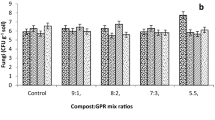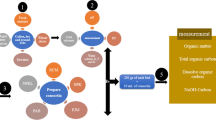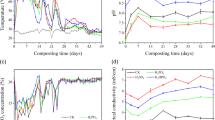Abstract
Purpose
The objective of this work was to evaluate the composting process of agro-industrial waste (coffee husk, plantain peel, bovine manure, and food waste) with rock phosphate supplementation using static piles with forced aeration.
Methods
Three 5-tonne piles of waste were composted in each treatment; supplementation treatment contained 15% (dry basis) rock phosphate and the control did not. Carbon/nitrogen ratio, total and soluble phosphorus, oxygen concentration, pH, and temperature were measured throughout composting.
Results
Both treatments reached final C/N ratios about 9.0. Total and soluble phosphorus was higher for supplemented piles (6.4% and 154 ppm, respectively) compared to control (3.1% and 106 ppm, respectively). The lowest oxygen concentrations (below 40% oxygen saturation) was observed in the first 15 weeks. Based on their Solubilization Index (SI), 203 isolations of phosphate-solubilizing bacteria were obtained and characterized. For supplemented piles, molecular identification was made to the two isolates with the highest SI in the mesophilic phase and to one isolate in the thermophilic phase. Mesophilic isolates were identified as Pseudomonas aeruginosa and the thermophilic one as Nocardiopsis spp. (99% probability).
Conclusion
Rock phosphate addition did not affect the final product quality, since both treatments comply with the parameters of mature compost. Compost supplementation with rock phosphate is a viable strategy not only to supply phosphorus to the soil, but also to increase its content of phosphate-solubilizing bacteria.
Graphic Abstract





Similar content being viewed by others
References
Altomare, C., Tringovska, I.: Beneficial soil microorganisms, an ecological alternative for soil fertility management. In: Lichtfouse, E. (ed.) Genetics, Biofuels and Local Farming Systems Sustainable Agriculture Reviews, vol. 7, pp. 161–214. Springer, Netherlands (2011)
White, P.J., Brown, P.H.: Plant nutrition for sustainable development and global health. Ann. Bot. 105, 1073–1080 (2010). https://doi.org/10.1093/aob/mcq085
Biswas, D.R., Narayanasamy, G.: Rock phosphate enriched compost: an approach to improve low-grade Indian rock phosphate. Bioresour. Technol. 97(18), 2243–2251 (2006). https://doi.org/10.1016/j.biortech.2006.02.004
Fernández, L.A., Zabala, P., Gomez, M.A., Sagardoy, M.A.: Bacterias solubilizadoras de fosfato inorgánico aisladas del suelo de la región sojera. Cienc. Suelo 23, 31–37 (2005)
Hernández-Leal, T., Carrión, G., Heredia, G.: Solubilización in vitro de fosfatos por una cepa de Paecilomyces lilacinus (Thom) Samson. Agrociencia 45, 881–892 (2011)
Sánchez, Ó.J., Ospina, D.A., Montoya, S.: Compost supplementation with nutrients and microorganisms in composting process. Waste Manage. 69, 136–153 (2017). https://doi.org/10.1016/j.wasman.2017.08.012
Mora, J.R.: Contribuciones del compost al mejoramiento de la fertilidad de los suelos Rev. Luna Azul 1–6 (2006).
Nishanth, D., Biswas, D.R.: Kinetics of phosphorus and potassium release from rock phosphate and waste mica enriched compost and their effect on yield and nutrient uptake by wheat (Triticum aestivum). Bioresour. Technol. 99, 3342–3353 (2008)
Zayed, G., Abdel-Motaal, H.: Bio-active composts from rice straw enriched with rock phosphate and their effect on the phosphorous nutrition and microbial community in rhizosphere of cowpea. Bioresour. Technol. 96, 929–935 (2005)
Meena, M.D., Biswas, D.R.: Effect of rock phosphate enriched compost and chemical fertilizers on microbial biomass phosphorus and phosphorus fractions. Afr. J. Microbiol. Res. 9(23), 1519–1526 (2015).
Shammas, N.K., Wang, L.K.: Biosolids composting. In: Wang, L.K., Pereira, N.C., Hung, Y.T., Shammas, N.K. (eds.) Biological Treatment Processes. Handbook of Environmental Engineering Series, vol. 8, pp. 669–713. Humana Press, Inc., Totowa (2009)
Leal, N., Madrid, C.: Compostaje de residuos orgánicos mezclados con roca fosfórica. Agron. Trop. 48, 335–357 (1998)
Wickramatilake, A.R., Munehiro, R., Nagaoka, T., Wasaki, J., Kouno, K.: Compost amendment enhances population and composition of phosphate solubilizing bacteria and improves phosphorus availability in granitic regosols. Soil Sci. Plant Nutr. 57, 529–540 (2011). https://doi.org/10.1080/00380768.2011.600243
Lara, C., Esquivel, L.M., Negrete, J.L.: Bacterias nativas solubilizadores de fosfatos para incrementar los cultivos en el departamento de Córdoba-Colombia. Biotecnol. Sector Agrop. Agroind. 9, 114–120 (2011)
ICONTEC: NTC 5167. Productos para la industria agrícola. Productos orgánicos usados como abonos o fertilizantes y enmienda o acondicionadores de suelo. In: NTC 5167. p. 52. Instituto Colombiano de Normas Técnicas y Certificación (ICONTEC), Bogotá (2011)
Bernal, M.P., Sánchez, M.A., Paredes, C., Roig, A.: Carbon mineralization from organic wastes at different composting stages during their incubation with soil. Agric. Ecosyst. Environ. 69, 175–189 (1998).
Kjeldahl, J.: Neue methode zur bestimmung des stickstoffs in organischen körpern (New method for the determination of nitrogen in organic bodies, in German). Z. Anal. Chem. 22(1), 366–382 (1883). https://doi.org/10.1007/bf01338151
Altieri, R., Esposito, A.: Evaluation of the fertilizing effect of olive mill waste compost in short-term crops. Int. Biodeterior. Biodegrad. 64, 124–128 (2010)
Chang, C.-H., Yang, S.-S.: Thermo-tolerant phosphate-solubilizing microbes for multi-functional biofertilizer preparation. Bioresour. Technol. 100(4), 1648–1658 (2009). https://doi.org/10.1016/j.biortech.2008.09.009
ICONTEC: NTC 5350. Calidad de suelo. Determinacion de fósforo disponible. In: NTC 5350, vol. 5350. vol. 1, p. 19. Instituto Colombiano de Normas Técnicas y Certificación (ICONTEC), Bogotá (2016)
Mehta, S., Nautiyal, C.S.: An efficient method for qualitative screening of phosphate-solubilizing bacteria. Curr. Microbiol. 43(1), 51–56 (2001). https://doi.org/10.1007/s002840010259
González, A.C., Robles, L., Nuñez, A., Strap, J.L., Crawford D.L.: Análisis molecular y cultural de actinomicetos estacionales en suelos del hábitat de Artemisia tridentata. Rev. Int. Botan. Exper. 78, 83–90 (2009).
Bobadilla, C., Rincón, S.C.: Aislamiento y producción de bacterias fosfato solubilizadoras a partir de compost obtenido de residuos de plaza (Isolation and production of phosphate-solubilizing bacteria from compost obtained from market place waste, in Spanish). Pontificia Universidad Javeriana, Pregrado (2008)
Kumar, V., Narula, N.: Solubilization of inorganic phosphates and growth emergence of wheat as affected by Azotobacter chroococcum mutants. Biol. Fertil. Soils 28(3), 301–305 (1999). https://doi.org/10.1007/s003740050497
Shilev, S., Naydenov, M., Vancheva, V., Aladjadjiyan, A.: Composting of food and agricultural wastes. In: Oreopoulou, V., Russ, W. (eds.) Utilization of By-Products and Treatment of Wastes in the Food Industry, vol. 3, pp. 283–301. Springer, New York (2007)
Waszkielis, K.M., Białobrzewski, I., Nowak, K.W., Dzadz, Ł., Dach, J.: Determination of the thermal conductivity of composted material. Measurement 58, 441–447 (2014). https://doi.org/10.1016/j.measurement.2014.09.006
Insam, H., de Bertoldi, M.: Microbiology of the composting process. In: Diaz, L.F., de Bertoldi, M., Bidlingmaier, W., Golueke, C. (eds.) Compost Science and Technology. Waste Management Series, vol. 8, pp. 25–48. Elsevier, New York (2007)
Bustamante, M.A., Ceglie, F.G., Aly, A., Mihreteab, H.T., Ciaccia, C., Tittarelli, F.: Phosphorus availability from rock phosphate: combined effect of green waste composting and sulfur addition. J. Environ. Manage. 182, 557–563 (2016). https://doi.org/10.1016/j.jenvman.2016.08.016
Jeong, Y.K., Kim, J.S.: A new method for conservation of nitrogen in aerobic composting processes. Bioresour. Technol. 79(2), 129–133 (2001)
Jeong, Y.K., Hwang, S.J.: Optimum doses of Mg and P salts for precipitating ammonia into struvite crystals in aerobic composting. Bioresour. Technol. 96(1), 1–6 (2005). https://doi.org/10.1016/j.biortech.2004.05.028
Pandey, A., Gaind, S., Ali, A., Nain, L.: Effect of bioaugmentation and nitrogen supplementation on composting of paddy straw. Biodegradation 20, 293–306 (2009)
Berrocal Rosso, E.P., Durango Petro, J.M., Barrera Violeth, J.L., Diaz Pongutá, B.: Evaluación de formas de fósforo en suelos cultivados con plátano (Evaluation of phosphorus forms in soils cropped with plantain, in Spanish). Acta Agron. 58(3), 152–159 (2009)
Fankem, H., Abba, M., Ngo Nkot, L., Deubel, A., Merbach, W., Etoa, F.-X., Nwaga, D.: Selecting indigenous P-solubilizing bacteria for cowpea and millet improvement in nutrient-deficient acidic soils of southern cameroon. In: Bationo, A., Waswa, B., Okeyo, M.J., Maina, F., Kihara, M.J. (eds.) Innovations as Key to the Green Revolution in Africa: Exploring the Scientific Facts, pp. 391–398. Springer, Netherlands, Dordrecht (2011)
Khan, M.S., Zaidi, A., Ahmad, E.: Mechanism of phosphate solubilization and physiological functions of phosphate-solubilizing microorganisms. In: Khan, M.S., Zaidi, A., Musarrat, J. (eds.) Phosphate Solubilizing Microorganisms: Principles and Application of Microphos Technology, pp. 31–62. Springer, Cham, Switzerland (2014)
Iyamuremye, F., Dick, R.P., Baham, J.: Organic amendments and phosphorus dynamics: I. Phosphorus chemistry and sorption. Soil Sci. 161(7), 426–435 (1996)
Fuentes, B., Bolan, N., Naidu, R., Mora, M.D.L.L.: Phosphorus in organic waste-soil systems. Rev. Cienc. Suelo Nutr. 6(2), 64–83 (2006). https://doi.org/10.4067/S0718-27912006000200006
Pypers, P., Verstraete, S., Thi, C.P., Merckx, R.: Changes in mineral nitrogen, phosphorus availability and salt-extractable aluminium following the application of green manure residues in two weathered soils of South Vietnam. Soil Biol. Biochem. 37(1), 163–172 (2005). https://doi.org/10.1016/j.soilbio.2004.06.018
Rynk, R.: On-farm composting handbook. Northeast Regional Agricultural Engineering Service, Ithaca, NY (1992)
Hasan, K.M., Sarkar, G., Alamgir, M., Bari, Q.H., Haedrich, G.: Study on the quality and stability of compost through a Demo Compost Plant. Waste Manag 32(11), 2046–2055 (2012). https://doi.org/10.1016/j.wasman.2012.05.039
Zhang, X., Cao, Y., Tian, Y., Li, J.: Short-term compost application increases rhizosphere soil carbon mineralization and stimulates root growth in long-term continuously cropped cucumber. Sci. Hortic. 175, 269–277 (2014)
Ryckeboer, J., Mergaert, J., Coosemans, J., Deprins, K., Swings, J.: Microbiological aspects of biowaste during composting in a monitored compost bin. J. Appl. Microbiol. 94, 127–137 (2003)
Paściak, M., Krzysztof Pawlik, K., Gamian, A., Szponar, B., Skóra, J., Gutarowska, B.: An airborne actinobacteria Nocardiopsis alba isolated from bioaerosol of a mushroom compost facility. Aerobiologia 30, 413–422 (2014)
Pathalam, G., Rajendran, H.A.D., Appadurai, D.R., Gandhi, M.R., Michael, G.P., Savarimuthu, I., Naif, A.A.-D.: Isolation and molecular characterization of actinomycetes with antimicrobial and mosquito larvicidal properties. Beni-Suef Univ. J. Appl. Sci. 6(2), 209–217 (2017). https://doi.org/10.1016/j.bjbas.2017.04.002
García-Valdés, E., Lalucat, J.: Pseudomonas: molecular phylogeny and current taxonomy. Molecular and Applied Biology. Springer International Publishing, Cham, Pseudomonas (2016)
He, S.T., Zhi, X.Y., Jiang, H., Yang, L.L., Wu, J.Y., Zhang, Y.G., Hozzein, W.N., Li, W.J.: Biogeography of Nocardiopsis strains from hypersaline environments of Yunnan and Xinjiang Provinces, western China. Sci Rep 5, 13323 (2015). https://doi.org/10.1038/srep13323
Acknowledgements
The authors thank the Bioprocess and Agro-industry Plant at the Universidad de Caldas for scientific and technical assistance during the development of this work. This work was supported by the Fund for Science, Technology and Innovation of the Colombian General System of Royalties (Grant BIPIN 2012000100178) and the Universidad de Caldas (Grant 0700413) through the research project Implementation of a comprehensive strategy through biotechnological innovation for waste utilization in Caldas province.
Author information
Authors and Affiliations
Corresponding author
Additional information
Publisher's Note
Springer Nature remains neutral with regard to jurisdictional claims in published maps and institutional affiliations.
Electronic supplementary material
Below is the link to the electronic supplementary material.
Rights and permissions
About this article
Cite this article
Montoya, S., Ospina, D.A. & Sánchez, Ó.J. Evaluation of the Physical–Chemical and Microbiological Characteristics of the Phospho-Compost Produced Under Forced Aeration System at the Industrial Scale. Waste Biomass Valor 11, 5977–5990 (2020). https://doi.org/10.1007/s12649-019-00813-8
Received:
Accepted:
Published:
Issue Date:
DOI: https://doi.org/10.1007/s12649-019-00813-8




